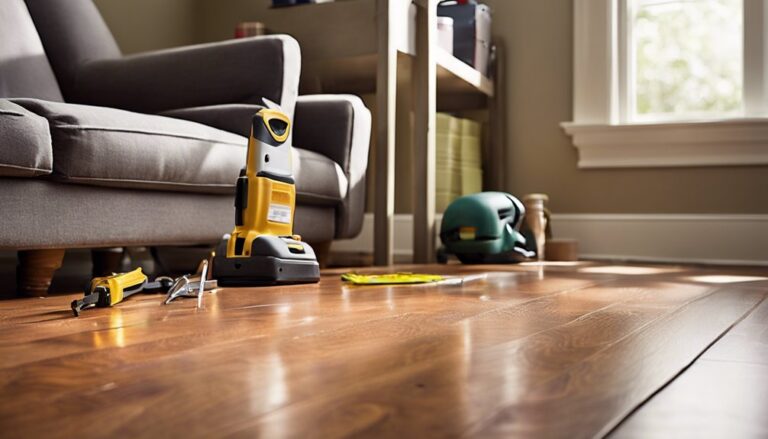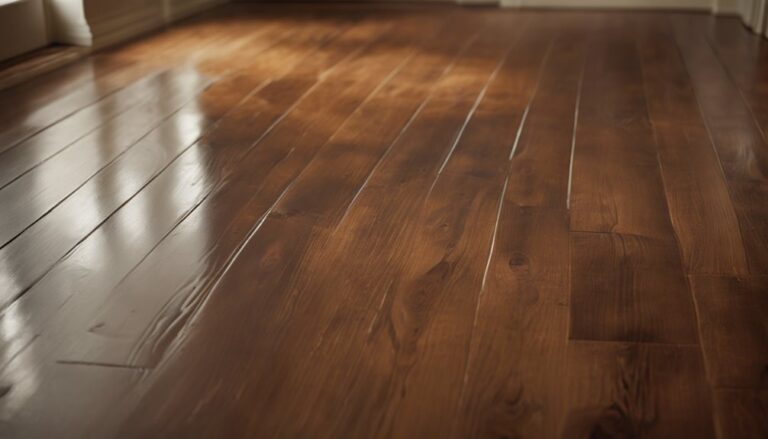To disinfect laminate floors safely, start by sweeping or vacuuming to remove dirt. Use a microfiber mop lightly dampened with a diluted disinfectant like white vinegar, mild dish soap, or an isopropyl alcohol solution—never soak the floor. Focus on high-traffic spots and dry immediately to prevent moisture damage. Avoid harsh chemicals like bleach or ammonia that can harm the finish. If you want to keep your floors both clean and germ-free, there’s a smart routine you’ll want to follow.
Understanding Laminate Flooring and Its Vulnerabilities

Although laminate flooring is designed to be durable and affordable, you should know it’s sensitive to moisture and harsh chemicals, which can cause warping or discoloration. Understanding laminate flooring types helps you choose the right care approach. Most laminate floors feature a wear layer, a design layer, a core, and a backing, each contributing to overall durability. However, laminate durability concerns mainly stem from exposure to excessive water and abrasive cleaners. You’ll want to avoid standing water and harsh disinfectants that can damage the surface or seep into seams. By recognizing these vulnerabilities, you maintain your floor’s integrity and appearance, giving you the freedom to enjoy a clean, attractive space without risking costly damage or premature wear.
Essential Tools and Supplies for Disinfecting Laminate Floors
Knowing how sensitive laminate floors are to moisture and harsh chemicals, you’ll want to choose your cleaning tools and supplies carefully. Start with a microfiber mop or cloth, as these absorb minimal water and won’t scratch the surface. Select disinfecting agents specifically labeled safe for laminate flooring—avoid bleach or ammonia-based products that can damage the finish. A spray bottle can help you apply disinfecting agents evenly without over-wetting the piso. For stubborn spots, a soft-bristled brush works well without harming the laminate. Mastering proper cleaning techniques, like lightly misting the floor and wiping promptly, guarantees you disinfect effectively while preserving your floor’s integrity. Using the right combination of tools and disinfecting agents lets you maintain a clean, safe environment without sacrificing your freedom to move and live comfortably.
Preparing the Floor Surface Before Disinfection

Before you start disinfecting, make certain to remove all loose debris from the laminate floor to prevent scratches and guarantee effective cleaning. Use a soft broom or vacuum with a hard floor setting to avoid damaging the surface. Choosing the right cleaning tools sets the foundation for proper disinfection and protects your flooring.
Eliminar residuos sueltos
Dust and dirt can prevent disinfectants from reaching the laminate surface effectively, so you’ll want to remove all loose debris first. Start by using proper sweeping techniques—gently push dirt toward a dustpan without scratching the floor. Alternatively, vacuum tips include selecting a soft-brush attachment to avoid damage while efficiently lifting dust and hair.
| Método | Key Tip |
|---|---|
| General | Use a soft-bristle broom |
| Vacuuming | Attach soft brush |
| Limpieza de manchas | Wipe stubborn spots dry |
Removing this debris guarantees your disinfectant works on a clean surface, boosting its effectiveness and keeping your laminate floors looking fresh and intact. Taking this step sets the stage for thorough disinfection without risking damage.
Choose Appropriate Cleaning Tools
After clearing away loose debris, the next step is selecting the right tools to clean your laminate floors without causing damage. Opt for soft microfiber mops or cloths that effectively trap dirt and won’t scratch the surface. Avoid abrasive scrubbers or brushes with stiff bristles, as they can wear down the laminate finish. When choosing cleaning tools, consider those compatible with your disinfecting products to guarantee even application and avoid residue buildup. A spray bottle can help you apply disinfecting solutions lightly and evenly, preventing excess moisture from seeping into floor seams. Using appropriate cleaning tools not only protects your floors but also maximizes the effectiveness of your disinfecting products, giving you peace of mind while maintaining freedom to move confidently across spotless laminate surfaces.
Safe Cleaning Solutions for Laminate Floors
When choosing a disinfectant for laminate floors, you’ll want to prioritize solutions that effectively kill germs without damaging the surface. Opting for eco friendly cleaners guarantees your laminate floor maintenance stays safe, preserving both your floor’s finish and your indoor air quality. Avoid harsh chemicals like bleach or ammonia, which can strip protective coatings. Instead, consider these safe options:
Choose gentle, eco-friendly disinfectants to protect your laminate floors and maintain indoor air quality.
- Diluted white vinegar solution (use sparingly)
- Jabón lavavajillas suave mezclado con agua tibia.
- Commercial laminate floor cleaners labeled as safe
- Isopropyl alcohol diluted with water for spot disinfection
- Microfiber mop with a gentle cleaning solution
Step-by-Step Guide to Disinfecting Laminate Floors

Choosing the right disinfectant is just the first step; now, let’s walk through how to properly disinfect your laminate floors to keep them spotless and germ-free. Begin by sweeping or vacuuming to remove dust and debris, ensuring the surface is ready for effective disinfecting methods. Next, lightly dampen a microfiber mop with your chosen disinfectant solution—never soak the floor, as excess moisture can damage laminate. Mop systematically, covering small sections at a time for thorough sanitization. Allow the floor to air dry completely before walking on it to maximize germ elimination. Regular floor maintenance, including timely disinfecting, extends your laminate’s lifespan and maintains its appearance. By following these precise steps, you’ll enjoy clean, germ-free floors without compromising their integrity or your freedom to live worry-free.
How to Avoid Moisture Damage During Disinfection
Although disinfecting your laminate floors is essential, you’ve got to be cautious about moisture exposure. Excess moisture can seep into seams, causing warping or damage. To maintain your floor’s integrity, focus on moisture control and protective measures during cleaning.
Disinfect laminate floors carefully to prevent moisture damage and keep them looking great.
Here’s how to avoid moisture damage during disinfection:
- Use a well-wrung microfiber mop to apply disinfectant lightly.
- Avoid soaking the floor with liquids; opt for spray bottles instead.
- Clean in small sections to prevent prolonged moisture exposure.
- Ventilate the area to speed drying and reduce humidity.
- Immediately wipe up any spills or standing liquid.
Natural Disinfectants That Work Well on Laminate
You can use natural disinfectants like vinegar solutions to effectively clean laminate floors without causing damage. Adding essential oils not only boosts the disinfecting power but also leaves a pleasant scent. For tougher grime, baking soda offers gentle abrasion while maintaining your floor’s finish.
Vinegar Solutions Benefits
Vinegar solutions offer an effective and natural way to disinfect laminate floors without risking damage. Thanks to vinegar’s effectiveness as a natural disinfectant, you can keep your floors clean and germ-free without harsh chemicals. This solution is ideal if you want a safe, eco-friendly option that preserves your floor’s finish while combating bacteria and viruses.
- Contains acetic acid, which kills many pathogens naturally
- Leaves no harmful residues, protecting your indoor air quality
- Safe for regular use without deteriorating laminate surfaces
- Inexpensive and easy to prepare at home with water and vinegar
- Offers a gentle, streak-free shine, maintaining your floor’s appearance
Using vinegar empowers you to maintain a fresh, healthy space while honoring your desire for freedom from synthetic cleaners.
Essential Oils Usage
Building on the benefits of vinegar solutions, incorporating essential oils can enhance your laminate floor cleaning routine with natural disinfectants that also add pleasant aromas. The essential oils benefits include antimicrobial properties and a fresh scent without harsh chemicals. You’ll find popular oil types like tea tree, lavender, and eucalyptus effective and safe for laminate surfaces.
Here’s a quick guide:
| Aceite esencial | Disinfectant Properties | Aroma Profile |
|---|---|---|
| Árbol del té | Strong antimicrobial | Medicinal, fresh |
| Lavanda | Antibacterial, calming | Floral, soothing |
| Eucalipto | Antiviral, antifungal | Minty, invigorating |
Mix a few drops with water and vinegar for a powerful, natural cleaner that keeps your floors fresh and germ-free, giving you the freedom to clean safely and efficiently.
Baking Soda Cleaning
Although often overlooked, baking soda is a powerful natural disinfectant that works exceptionally well on laminate floors. Its gentle abrasiveness and deodorizing properties make it ideal for safe, effective cleaning without harsh chemicals. When you understand the baking soda benefits, it’s clear why it’s a top choice for maintaining freedom from toxins in your home.
For the best baking soda application on laminate floors:
- Sprinkle baking soda evenly over the floor.
- Gently scrub with a damp microfiber mop or cloth.
- Let it sit for 10–15 minutes to disinfect.
- Wipe away residue with a clean, damp mop.
- Dry the floor thoroughly to prevent damage.
This method guarantees a fresh, bacteria-free surface while preserving your flooring’s finish and your indoor air quality.
Disinfecting High-Traffic Areas and Stubborn Spots
When tackling high-traffic areas and stubborn spots on your laminate floors, you’ll need more targeted disinfecting methods than usual. For high traffic disinfecting, focus on using a diluted solution of isopropyl alcohol and water; it effectively eliminates germs without damaging the surface. Apply it with a microfiber cloth, ensuring you cover worn areas thoroughly. For stubborn spot treatments like sticky residues or scuffs, gently scrub with a soft-bristle brush dipped in a mild dish soap solution. Avoid harsh abrasives that can strip the laminate’s finish. After treating these areas, wipe with a damp cloth to remove any residue and dry immediately to prevent moisture damage. These focused approaches let you maintain cleanliness and protect your floors, so you’re free to enjoy your space without worry.
Frequency and Timing for Laminate Floor Disinfection
Keeping your laminate floors disinfected at the right intervals is key to maintaining their appearance and hygiene without causing damage. Understanding the disinfection frequency and timing recommendations helps you avoid over-wetting or wearing down the surface. Generally, disinfect high-traffic areas once or twice a week, while less-used spaces can be treated every two weeks. Timing matters: avoid disinfecting right after mopping to prevent residue buildup.
Disinfect laminate floors regularly—weekly for busy areas, biweekly for others—to maintain hygiene without damage.
Consider these points for effective scheduling:
- Disinfect after spills or visible dirt to prevent bacteria buildup
- Increase frequency during flu season or illness
- Avoid disinfecting in direct sunlight to prevent streaks
- Use a gentle disinfectant suited for laminate surfaces
- Allow floors to dry completely between treatments
Tips for Maintaining a Germ-Free Laminate Floor Between Deep Cleans
To keep your laminate floors germ-free between deep cleans, focus on daily cleaning practices like sweeping and using a damp microfiber mop. Quick germ-reducing methods, such as spot disinfecting high-traffic areas, can help minimize bacteria buildup. These simple steps maintain hygiene without risking damage to your floors.
Daily Cleaning Practices
Maintaining a germ-free laminate floor daily requires simple yet effective habits. Establishing daily disinfecting routines is key to preventing buildup and keeping your floors fresh between deep cleans. Stick to effective cleaning schedules that fit your lifestyle without consuming too much time.
- Sweep or vacuum daily to remove dirt and debris that harbor germs
- Use a damp microfiber mop with a gentle disinfectant solution
- Wipe up spills immediately to avoid sticky residues and bacterial growth
- Place doormats at entrances to reduce dirt tracked inside
- Avoid harsh chemicals that can damage laminate surfaces
Quick Germ-Reducing Methods
Although deep cleaning is essential, you don’t have to wait for it to keep your laminate floors germ-free. Focus on germ hotspots like entryways, under tables, and high-traffic zones by wiping them down regularly with a microfiber cloth dampened with a mild disinfectant. Quick solutions such as spray-and-wipe methods using a diluted vinegar solution or alcohol-based cleaners can effectively reduce microbes without damaging your floor’s finish. Use doormats to limit dirt and germs tracked inside, and encourage shoe removal to maintain cleanliness. Spot cleaning spills immediately also prevents bacterial growth. By targeting these key areas and employing efficient techniques, you’ll maintain a healthier environment between deep cleans while enjoying the freedom of a spotless, germ-reduced laminate floor.




